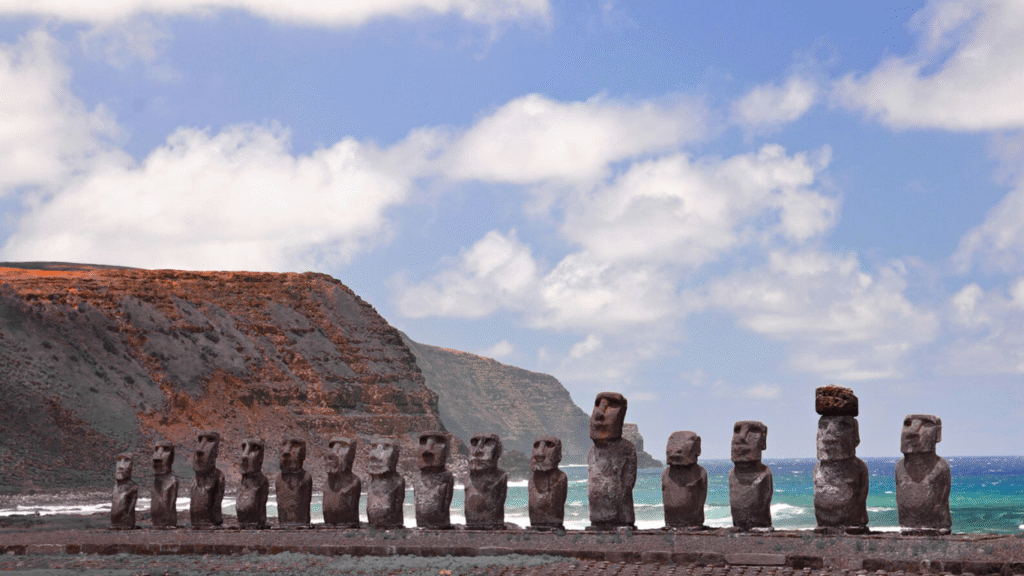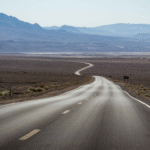Easter Island, a tiny speck in the Pacific Ocean, is one of Earth’s most mysterious places. Known as Rapa Nui, this remote island, 2,200 miles from Chile, is famous for its 900 moai statues—giant stone figures carved by the Rapa Nui people between 1100 and 1600 AD. Some stand 30 feet tall and weigh 80 tons, staring silently across the barren landscape. How were they carved and moved without modern tools? Why were they built? The island’s isolation adds to the enigma, as does the collapse of its civilization. Theories point to ancestor worship, status symbols, or spiritual rituals, while others whisper of lost knowledge. A UNESCO World Heritage Site, Easter Island draws adventurers and scholars to its windswept shores, seeking answers. This article explores the moai, the island’s history, and why its secrets keep us captivated, making Rapa Nui a haunting puzzle of human ambition and mystery.
The History of Easter Island
Easter Island’s story begins around 800 AD when Polynesian settlers arrived by canoe, naming it Rapa Nui. From 1100 to 1600 AD, they carved nearly 900 moai, placing them on stone platforms called ahu. These statues, tied to their culture, marked a thriving society. By the 1700s, the population crashed, likely from deforestation, resource scarcity, or clan wars. When Europeans arrived in 1722, they found a struggling island, with many moai toppled. Disease and slave raids later decimated the Rapa Nui people. Rediscovered as a mystery in the 19th century, the island became a focus for archaeologists. Today, it’s a protected site, but its past—glorious and tragic—remains unclear. The moai stand as clues to a lost world, their creation and the civilization’s fall fueling questions that keep Easter Island a global fascination.
Arrival of the Rapa Nui People
Around 800 AD, Polynesians sailed thousands of miles to settle Easter Island, likely from the Marquesas or Gambier Islands. They brought crops like taro and built a complex society. By 1100 AD, they began carving moai, a sign of cultural strength. Villages grew near ahu platforms, suggesting community pride. Their seafaring skill and resourcefulness were remarkable, but the island’s isolation shaped a unique culture. Without written records, we rely on oral tales and archaeology, leaving gaps in how these settlers turned a barren rock into a home for giants.
Collapse of the Civilization
By the 1700s, the Rapa Nui civilization crumbled. Deforestation, possibly from cutting trees to move moai, left no wood for boats or farming. Soil erosion hurt crops, and clan wars may have erupted over scarce resources. Many moai were toppled, perhaps in conflict. European contact in 1722 brought disease, and later slave raids in the 1800s nearly wiped out the population. By 1877, only 111 Rapa Nui remained. This tragic collapse, pieced from bones and ruins, leaves us wondering how a vibrant society fell so fast.
The Moai Statues
The moai, Easter Island’s iconic stone giants, are the heart of its mystery. Carved from volcanic rock, these statues—some 30 feet tall and 80 tons—number nearly 900. Most face inland, watching over villages, with coral eyes adding eerie life. Built between 1100 and 1600 AD, they were placed on ahu platforms along the coast. How the Rapa Nui carved and moved them with simple tools baffles experts. Theories suggest they honored ancestors or chiefs, but their purpose isn’t clear. Many were toppled during the island’s decline, and some remain unfinished in quarries. Restored moai now stand proud, drawing tourists to marvel at their size and silence, a testament to a culture’s skill and a puzzle that keeps us guessing.
Carving and Construction
The Rapa Nui carved moai from tuff, a soft volcanic rock, at Rano Raraku quarry. Using stone tools, they shaped faces with long noses and chins, some with coral eyes. Most moai were carved lying down, then moved to ahu platforms. Unfinished statues, still in the rock, suggest sudden work stoppage. The precision and scale, without metal tools, show incredible skill. Some moai have pukao, red stone hats, adding to the challenge. The effort to create nearly 900 statues hints at a deep cultural drive, but why they stopped remains a mystery.
Transportation Theories
Moving moai across the island is a head-scratcher. Without wheels, the Rapa Nui likely used sledges, rollers, or ropes. Experiments show dozens of people could “walk” a moai upright using ropes, rocking it side to side. Trees may have been cut for logs, contributing to deforestation. Distances up to 11 miles and weights of 80 tons made this grueling. Some moai fell en route, left where they lay. These theories explain the how but not the why, leaving us in awe of the Rapa Nui’s determination to move giants across a rugged land.
The Purpose of the Moai
Why build the moai? No records say, but guesses abound. Most likely, they honored ancestors, chiefs, or gods, standing on ahu to watch over villages. Their inland gaze suggests protection or pride. Some think they marked clan status, with bigger moai showing power. Others see spiritual roles, tied to rituals or mana, a sacred force. The effort—carving, moving, and erecting—shows deep meaning, maybe tied to life and death. Wild theories claim alien guidance or cosmic signals, but evidence points to human devotion. The moai’s silence fuels debate, as their weathered faces offer no answers, only a haunting link to a culture that poured its heart into stone.
Ancestor Worship and Symbolism
Many believe the moai represented ancestors or chiefs, their faces carved to hold mana, a spiritual power. Placed on ahu, they faced villages, perhaps guarding or blessing them. Coral eyes gave them life-like stares. Each clan may have built moai to show strength or honor the dead. Burials near ahu support this, as do oral tales of ancestor veneration. The statues’ size and number suggest a cultural obsession, but without texts, we can’t be sure. Their role as symbols of lineage or power remains the strongest guess, tying them to Rapa Nui identity.
Alternative Theories
Some theories go beyond spirituality. Could moai have been territorial markers or astronomical tools? A few align with stars, but evidence is slim. Fringe ideas suggest aliens taught the Rapa Nui to carve them, citing their scale. No artifacts support this, and human skill explains it better. Other guesses include moai as offerings to gods or symbols of unity. These ideas, while creative, lack proof compared to ancestor worship. The moai’s mystery lets imaginations run wild, but their human origins—tied to faith or status—seem most likely, keeping the debate alive.
Easter Island in Modern Times
Easter Island is now a global draw, with 100,000 tourists yearly visiting to see the moai. A UNESCO site since 1995, it’s Chile’s pride, but its isolation—3,700 miles from Santiago—keeps it special. Locals, descended from the Rapa Nui, preserve their culture through festivals and language. Tourism boosts the economy but strains resources; planes and cruise ships bring crowds, risking damage to sites. Preservation efforts protect moai from erosion and vandalism, with some restored to stand again. The island stars in films, books, and documentaries, blending mystery with beauty. Its story of triumph and tragedy captivates, making Easter Island a living museum where the past meets the present.
Tourism and Preservation
Tourists flock to Easter Island for the moai, boosting Chile’s economy. Small planes land on the island’s single runway, and guides lead visitors to Rano Raraku and Ahu Tongariki. Overuse threatens sites—footsteps erode ahu, and climbing is banned. Restoration since the 1960s has uprighted many moai, but weather and time wear them down. Locals and UNESCO work to limit damage, using barriers and patrols. Climate change, with rising seas, is a new worry. Balancing access with protection ensures the moai endure, letting future generations marvel at Rapa Nui’s legacy.
Cultural Significance Today
The Rapa Nui people, about 7,000 strong, keep their culture alive. Festivals like Tapati celebrate music, dance, and moai history. The language, nearly lost, is taught in schools. The moai are sacred, tying locals to their ancestors. Globally, Easter Island inspires art, from Moana to documentaries about its collapse. Its story warns of environmental overuse, resonating today. For locals, it’s home; for the world, it’s a symbol of mystery and resilience. The moai’s gaze connects past and present, making the island a cultural treasure.
Why Easter Island Fascinates Us
Easter Island grips us because it’s a puzzle wrapped in beauty. The moai, carved by a remote people, defy logic—how did they do it, and why? Their size and number scream ambition, yet the civilization’s fall adds tragedy. Theories of ancestors or aliens keep us guessing, fueled by the island’s isolation. Pop culture, from movies to eco-warnings, makes it a modern myth. It’s a reminder that even small societies can create wonders, but also lose them. Easter Island’s mix of human triumph, mystery, and cautionary tale pulls us in, urging us to explore its past and protect its future.
The Mystery of the Moai
The moai’s creation is a riddle. How did a small island carve and move 900 giants? Their purpose—ancestors, gods, or status—eludes us. No records explain the effort or why many were toppled. This gap lets us imagine spiritual quests or lost techniques. The moai’s silent stares feel alive, hinting at a culture we barely know. Their mystery, unsolved after centuries, draws scholars and dreamers. It’s not just their size; it’s the question of what drove the Rapa Nui to build them, making Easter Island a timeless enigma.
Lessons from the Collapse
Easter Island’s fall teaches hard truths. Deforestation, likely from moving moai, starved the land. Wars and scarcity followed, toppling statues and people. European contact brought more ruin. This story warns of overusing resources, a lesson for today’s world. The moai stand as relics of a society that soared and crashed, urging us to balance ambition with care. Their haunting presence makes the island a symbol of human potential and fragility, resonating with anyone who ponders our planet’s future.
Conclusion
Easter Island, Chile, is a tiny land with a giant story. Its moai, carved centuries ago, stand as proof of Rapa Nui ingenuity and mystery. Built to honor ancestors or gods, their creation and the civilization’s collapse puzzle us still. From Polynesian settlers to modern tourists, the island’s tale blends triumph and tragedy. As a UNESCO site, it draws the world to its shores, its statues a silent link to a lost culture. Theories of purpose and lessons of environmental collapse keep Easter Island alive in our minds, a place where human spirit and unanswered questions meet under the Pacific sky.



